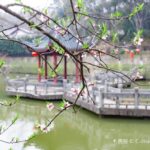Since the first year of Zhengde in the Ming Dynasty (1506), a building complex has been gradually completed on Gushan. According to historical records, climbing up the southern slope of Gushan back then, there was a ‘Niewen’ stone archway at the halfway point. There were couplets engraved on the stone pillars on both sides: Facing the Yangtze River and Zuo Li, the misty waves are still here as of today. Standing at the top, how about the scenery of the West Lake? The inscription and couplets were all written by the magistrate of Jingjiang County in the 42nd year of Wanli in the Ming Dynasty (1614). It can be seen that the Niewen Archway has a history of nearly 400 years and is an earlier existing stone archway in Jingjiang City. Under the archway, there is a cliff inscription that reads ‘In the summer of Bingxu year of Jiajing, Yizi Bozhen, a Taoist from Sanzi in Hunan, prayed for rain here’. It is a commemoration of Yizi Bozhen, a Taoist from Sanzi in Hunan, praying for rain here in the summer of Bingxu year of Jiajing in the Ming Dynasty (1526). Not far to the east of the Niewen Archway, there is the Temple of Emperor Guan. Turning west, there is the Temple of the Earth God. Then turning west and then north is the mountain gate. To the east of the gate is the Temple of the Three Mao Zhenjun. On the high slope to the west of the gate is the Immortal Terrace. In the cluster of ancient cypresses is the Guanyin Nunnery. To the north is a double gate. Entering the double gate is the Dongyue Palace, which is the main hall of Gushan Temple. Inside the hall, there are a hundred Buddha statues, resplendent and magnificent. Behind the temple is the ‘Bu Gu Pavilion’ with upturned eaves and carved beams and painted pillars. On the top of the back mountain is the ‘Wangjiang Tower’. Ascending the tower and looking into the distance, the clear river is like a silk ribbon, and the flat fields stretch for hundreds of miles. After hundreds of years of great changes, except for the remaining ruins of the Niewen Archway at Gushan Temple, all the buildings of that year have been destroyed. The couplets on both sides of the Niewen Archway have long been eroded away due to the long passage of time. The landscape of Gushan has also changed greatly. In 1993, the Gushan temple fair was resumed. In more than ten years, Gushan Temple has successively rebuilt facilities such as the mountain gate hall, Guanyin hall, Mahavira Hall, and Sanbao Tower. The six-meter-tall white marble Guanyin statue and the eight-meter-tall iron-cast Pharmacist Buddha statue in the temple are relatively large Buddha statues of the same material in the surrounding areas. Nowadays, Gushan has secluded paths. The morning bells and evening drums resound, and incense smoke curls. Every year on the third day of the third lunar month, a temple fair is held on Gushan. Devout men and women from Jingjiang and neighboring counties and towns come to worship and offer incense, and people swarm like a tide. Open all year round and all day long.
Gushan Temple
Since the first year of Zhengde in the Ming Dynasty (1506), a building complex has been gradually co[...]









